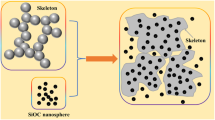Abstract
Nickel oxide (NiO) hollow fibers were obtained by thermal degradation of nickel alginate fibers (Ni-AF), which was prepared by wet spinning technique. The composition, morphology and microstructure of the as-obtained NiO fibers were investigated by thermal gravimetry (TG), X-ray diffraction (XRD), electron energy-loss spectroscopy (EELS), scanning electron microscopy (SEM), and transmission electron microscopy (TEM). It is found that temperature plays important roles on the final structures and shapes of the NiO nanostructures. NiO hollow fibers (∼ 10 μm) consisting of NiO nanoparticles with diameter about 50 and 80 nm respectively are obtained under 600 and 800 °C in air. The mechanism of Ni-AF thermal degradation and NiO growth were proposed.
Similar content being viewed by others
References
Jang W.L., Lu Y.M., Hwang W.S., and Chen W.C., Electrical properties of Li-doped NiO films, Journal of the European Ceramic Society, 2010, 30(2): 503.
Zhang W.B., Hu Y.L., and Tang B.Y., Phase stability and structural distortion of NiO under high pressure, Transactions of Nonferrous Metals Society of China, 2006, 16(S1): s52.
Hakim A., Hossain J., and Khan K.A., Temperature effect on the electrical properties of undoped NiO thin films, Renewable Energy, 2009, 34(12): 2625.
Wei Z.Q., Qiao H.X., Yang H., Zhang C.R., and Yan X.Y., Characterization of NiO nanoparticles by anodic arc plasma method, Journal of Alloys and Compounds, 2009, 479(1–2): 855.
Nikolić M.V., Blagojević V., Paraskevopoulos K.M., Zorba T.T., Vasiljević-Radović D., Nikolić P.M., and Ristić M.M., Far infrared properties of sintered NiO, Journal of the European Ceramic Society, 2007, 27(2–3): 469.
Steinebach H., Kannan S., Rieth L., and Solzbacher F., H2 gas sensor performance of NiO at high temperatures in gas mixtures, Sensors and Actuators B: Chemical, 2010, 151(1): 162.
Mattisson T., Johansson M., and Lyngfelt A., The use of NiO as an oxygen carrier in chemical-looping combustion, Fuel, 2006, 85(5–6): 736.
Deng Y.X., and Chen Z., Preparation of nano-NiO by ammonia precipitation and reaction in solution and cometitive balance, Materials Letters, 2004, 58(3–4): 276.
Haug A., Larsen B., and Smidsrød O., Uronic acid sequence in alginate from different sources, Carbohydrate Research, 1974, 32(2): 217.
Kong Q.S., Guo C.X., Cheng F.F., Ji Q., Li Y.H., and Xia Y.Z., Batch studies of zinc(II) ion adsorption onto alginate acid fibers, Adsorption Science and Technology, 2010, 28(4): 363.
Kong Q.S., Cheng F.F., Guo C.X., Ji Q., and Xia Y.Z., Study on the adsorption property of alginate acid fibers to Cu2+, Journal of Functional Materials, 2009, 40(7): 1130.
Kong Q.S, Ji Q., Yu J., and Xia Y.Z., Preparation and properties of alginate salt fibers: an inherent flame-retardant, biodegradable fiber, Materials Science Forum, 2009, 610–613: 48.
Kong Q.S., Wu X.L., Guo Y.G., Wang Y.Q., Xia Y.Z., Yu J., Liu H.H., and Duan X.F., Preparation and ZnO nanostructures by thermal degradation of zinc alginate fibers, Acta Phys. -Chim. Sin., 2008, 24(12): 2179.
Wu X.L., Chen L.L., Xin S., Yin Y.X., Guo Y.G., Kong Q.S., and Xia Y.Z., Preparation and Li storage properties of hierarchical porous carbon fibers derived from alginic acid, Chem. Sust. Ener. and Mater., 2010, 3(6): 703.
Gao S.Y., Shi Y.G., Zhang S.X., Jiang K., Yang S.X., Li Z.D., and Takayama-Muromachi, Biopolymer-assisted green synthesis of iron oxide nanoparticles and their magnetic properties, Journal of Physical Chemistry C, 2008, 112(28): 10398.
Said A.A., and Hassan R.M., Thermal decomposition of some divalent metal alginate gel compounds, Polymer Degradation and Stability, 1993, 39(3): 393.
Dodd A.C., A comparison of mechanochemical methods for the synthesis of nanoparticulate nickel oxide, Powder Technology, 2009, 196(1): 30.
Hagelin-Weaver H.A.E., Weaver J.F., Hoflund G.B., Salaita G.N., Electron energy loss spectroscopic investigation of Ni metal and NiO before and after surface reduction by Ar+ bombardment, Journal of Electron Spectroscopy and Related Phenomena, 2004, 134(2–3): 139.
Author information
Authors and Affiliations
Corresponding author
Rights and permissions
About this article
Cite this article
Kong, Q., Guo, C., Sun, Y. et al. Preparation and characterization of NiO hollow fibers consisting of nanoparticles derived from alginate salt precursor. Rare Metals 30 (Suppl 1), 208–212 (2011). https://doi.org/10.1007/s12598-011-0270-0
Received:
Revised:
Accepted:
Published:
Issue Date:
DOI: https://doi.org/10.1007/s12598-011-0270-0




